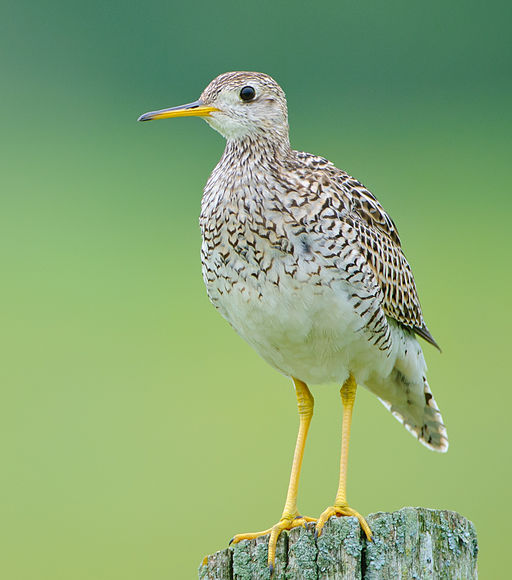If you’re in grasslands or fields in Wyoming and you keep getting whistled at, you’re hearing an upland sandpiper! These birds use their distinctive song to defend their breeding territory and attract mates. The upland sandpiper looks a little like its smaller and more common relative, the killdeer, but without the bold black striping on the chest and neck. You can often spot upland sandpipers perched on fenceposts. Insects make up more than 95 percent of their diet, including many we consider pests, such as horsefly larvae, grasshoppers, weevils and cutworms. Given their close association with native grasslands and a diet dependent on insects that are sensitive to pesticide use, these birds are considered prairie health indicator species. If you’ve got upland sandpipers, you’ve likely got healthy grasslands.
 Upland sandpipers are long-distance migrants, spending just four months of the year in the northern and central Great Plains for the breeding season, and the other eight months of the year in South America. Scientists have only recently developed solar-powered satellite transmitters that are light enough to use on these birds, which allow us to track their migration movements. These powerhouses of flight can travel upwards of 5,500 miles between their breeding and wintering grounds, and have been documented traveling four days straight without stopping. All this for a bird that weighs the equivalent of a cup of sugar!
Upland sandpipers are long-distance migrants, spending just four months of the year in the northern and central Great Plains for the breeding season, and the other eight months of the year in South America. Scientists have only recently developed solar-powered satellite transmitters that are light enough to use on these birds, which allow us to track their migration movements. These powerhouses of flight can travel upwards of 5,500 miles between their breeding and wintering grounds, and have been documented traveling four days straight without stopping. All this for a bird that weighs the equivalent of a cup of sugar!
The Wyoming Game and Fish Department is responsible for the health and management of all wildlife species, including birds like the upland sandpiper. To track their population in Wyoming over time, we count upland sandpiper during the spring breeding season. Biologists use that distinctive wolf-whistle to identify places with upland sandpiper and count their numbers.
The Wyoming Game and Fish Department is responsible for the health and management of all wildlife species, including birds like the upland sandpiper. To track their population in Wyoming over time, we count upland sandpiper during the spring breeding season. Biologists use that distinctive wolf-whistle to identify places with upland sandpiper and count their numbers.
Publish Date
Answered By
Anika Mahoney
Job Title
Nongame Biologist
Photo
AnikaMahoney_NongameBiologist_byCraigOkraska
Ask Game ID
204
Node order
108
Parent Node
1135
